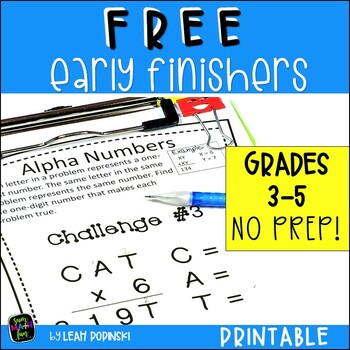- PDF
Also included in
- Solve all of your fast-finisher problems with these activities! This bundle of 140 enrichment activities is the answer to I'm done! Now what?! We call these early finishers or fast finishers activities. But really, these math brain teasers can be used with ALL of your students. They are ideal for mPrice $12.00Original Price $19.49Save $7.49
Description
Early finishers, fast finishers, gifted...whichever you have, these NO Prep free activities will be challenging and keep your students engaged and learning.
▶️ Find the FREE Google Slides version HERE.
Completing these early finishers and gifted tasks requires many skills including reasoning, math vocabulary, all four operations, even or odd numbers, and all areas of problem solving. Directions are included to enable students to complete the tasks independently or collaboratively with little instruction from you.
You may choose to have students justify their answers, or as I tell mine, “Convince Me!”. When working collaboratively, I give each group a large sheet of butcher paper. Each group is required to use equations, words, and visual representations to “Convince Me!” that their answer is correct. When time allows, groups present their solutions to the class. When working independently, students repeat this process in their journals.
Looking for more tasks to keep your early finishers and gifted students engaged and learning? Click the link below to see a video of our bundle with over 130 challenges!
❤️ Just print, laminate or use sheet protectors, and use year after year!
✋ Need more to keep those eager minds challenged? Check out these popular resources.
✅ Math Challenges for Smarty Pants #1 || Google Slides || Distance Learning
✅ Early Finishers: Activities for Gifted, Homework, & Extensions - BUNDLED!
✅ Bingo Division With Remainders Distance Learning Zoom Meetings
✅ Multi-Step Word Problem Task Cards 4th Grade
✅ Equivalent Fractions Task Cards Hands On
❤️Become a follower and take advantage of my Early Bird Specials! All new resources are 50% off for the first 48 hours! It pays to follow! :)
Thanks for taking your time to preview my product!
Have fun Mathing!
-Leah





